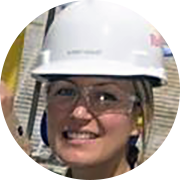At our Boron Operations in California, we are used to the heat. Located in the Mojave Desert, from June to September, the average daily temperature tops 90°F (32°C).
But far hotter still is Boron's Plant 5 furnace. Here, we use gas burners as part of our process to produce a powder sold as Dehybor® which is used in several applications including fiberglass products and mobile phone screens.
Upgrading burner ignition
In late 2017, our team began a project to upgrade the ignition system of the furnace’s forehearth burners. Changing such a major part of the processing operations is a huge undertaking. This project brought together employees from across asset management, operations, and maintenance as well as our external partners who supply the burner equipment. The successful way this group worked together was such a first-class example of teamwork that the project won Rio Tinto’s 2019 Chief Executive Pioneering Excellence Award for Safety.
Q&A with team lead Audrey Goulet, project engineer
 Audrey has a background in automation, and specializes in the health and safety aspects of process engineering.
Audrey has a background in automation, and specializes in the health and safety aspects of process engineering.
Q. How did the project begin?
A. Process safety is one of the highest priorities at Rio Tinto. Working on any process safety activity at Boron involves carrying out a bow-tie analysis on the system.
Q. What is a bow-tie analysis?
A. In the process safety world, a bow-tie is a common way to communicate risk visually so that it can be easily understood. If you imagine the knot in the middle of a bow-tie, that's the "event." When we were looking at our furnace, the event might be, for instance, if it over-pressurized.
Then you consider—on the left hand side of the bow-tie—what could cause the event, like a build-up of gas, and the things you could put in place to stop that from happening. You also consider the right hand side of the bow-tie, which would be the consequences, like an explosion, if the event were to occur—and how you could reduce the impact that would have.
Q. What happened after the bow-tie analysis?
A. First, we needed to gather as much information as we could about the furnace and the process we were using. The people who know this best are those who work here every day—the people who operate the furnace, and the maintainers who keep it working. So, we engaged with them from the outset, and throughout, to make sure we understood everything we could about the process, and benefit from all of their experience. That way, we could build the best system for them—the people who need to use it and maintain it—and the operation.
We put a lot of time and effort into this early part of the process, but I think that paid off when we got to installation and commissioning, because all that information they gave us helped us design the solution properly from the outset.
We also made sure we worked closely with our equipment supplier. We gave them all the information we gathered, and from that, they came up with the design of the burner management system.
Q. When did you get the new system up and running?
A. We installed and commissioned the new system during scheduled furnace shutdowns in 2018. We also put in a lot of energy during this part of the process to make sure the system was well understood by everyone who had to use it. And, because we had taken everyone's experiences into account at the start, it meant we could design training that would work best for them.
As well as the automated ignition system, we put in a new "block and bleed" valve that offers another layer of protection. If the furnace has a defect, it triggers a shutdown of the valve that feeds gas to the burners. The furnace meets the
U.S. National Fire Protection Association (NFPA) standard for best practice in operations that use natural gas.
Q. What were the highlights for you of working on this project?
A. For me, it was working with such an integrated team, where everyone was so supportive of what we were trying to achieve from the outset, and collaborated and communicated so well throughout. Everyone was engaged from the beginning and understood what a good thing the work would achieve. Commissioning took a bit longer than expected, but safety was always the priority. We had great support from management who made sure we had the extra time we needed to do this right.
Resources